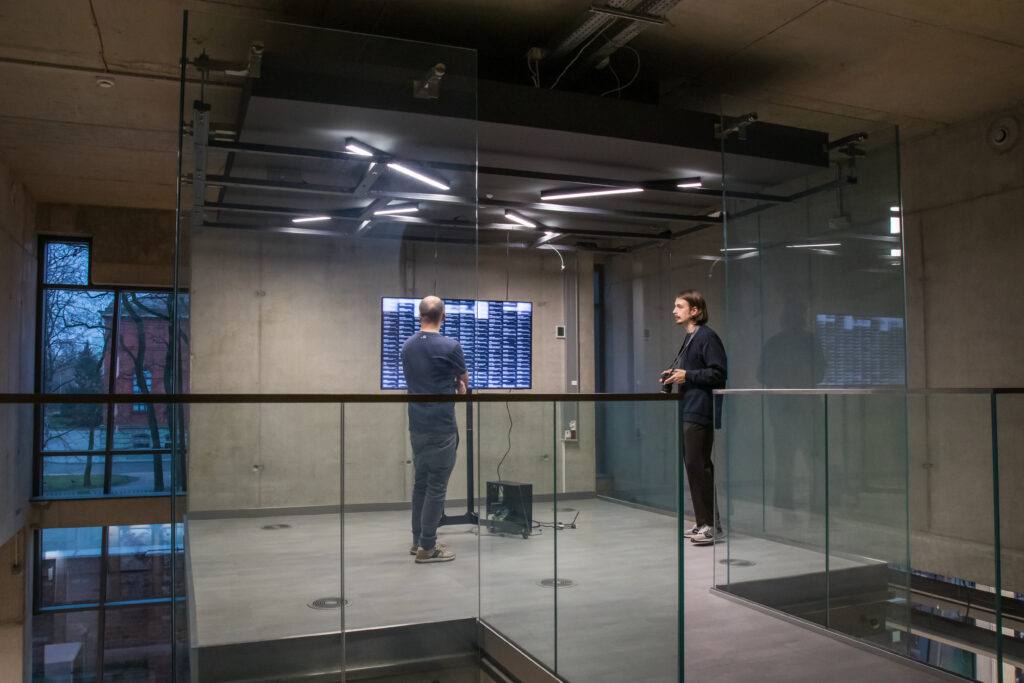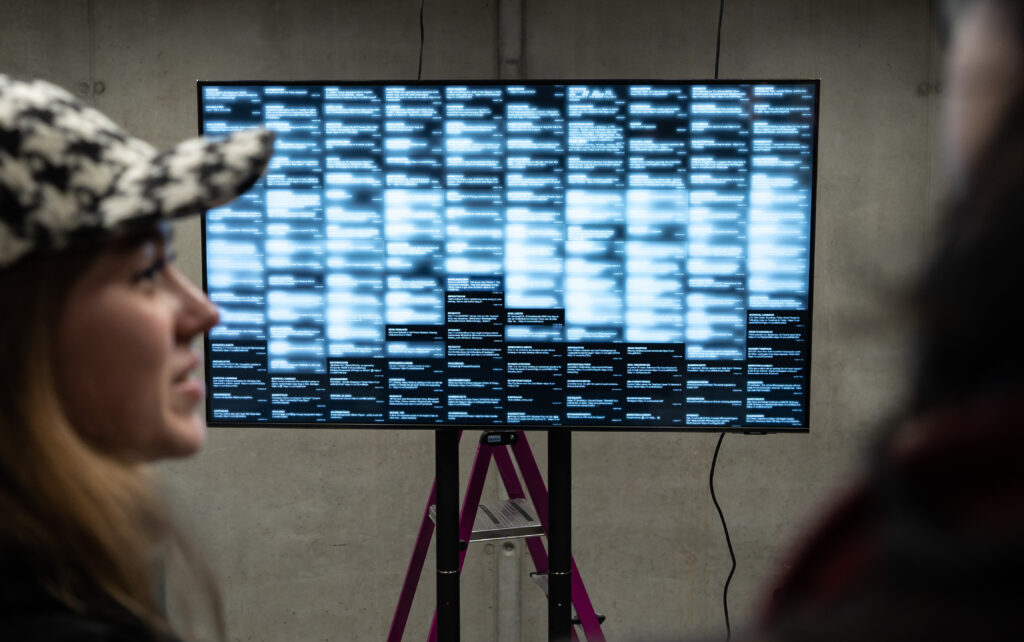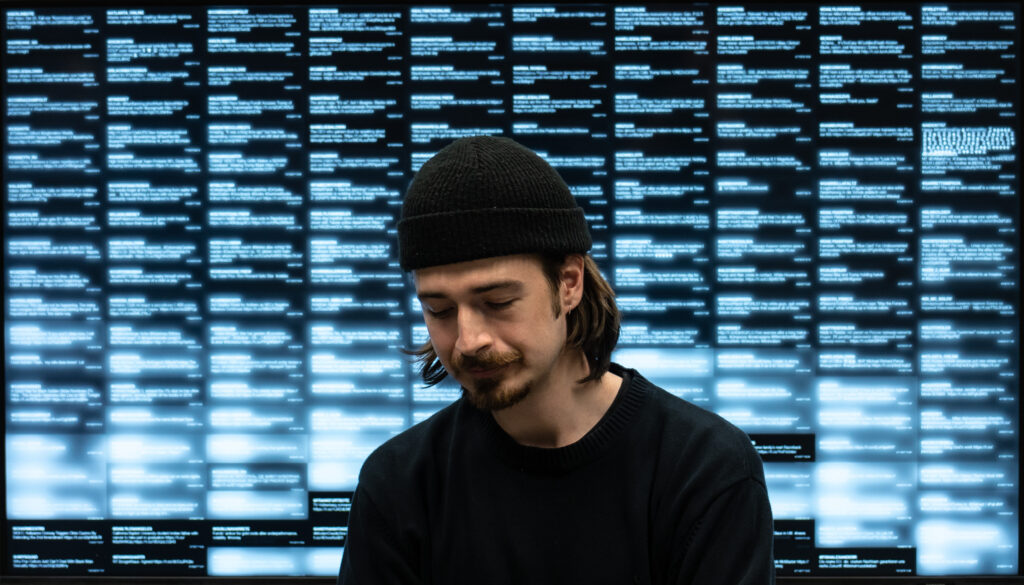KYU6U Gallery, Polish-Japanese Academy of Information Technology
exhibition open from January 10 to 22, 2023
curators: Anna Klimczak, Tomasz Miśkiewicz

Contrary to the belief that there is nothing new under the sun, digital technology, combined with diverse ideologies, has fundamentally transformed not only the information sphere, but also many aspects of individual and collective life.
Tomasz Stawiszyński
Benedikt Pfisterer’s project is based on theoretical considerations of disinformation, or informational noise in general. The very title 280 Characters seems intriguing. The number 280 represents the maximum number of characters that can fit into a single 'tweet’. The work expresses the power hidden in such a short form and seems to suggest the shallowness of conversation, exchanges and debates in new forms of media. The exhibition reveals the flow of virtual content that is created on the Internet, using a familiar written language that is by no means at the service of information, but is in fact quite the opposite. The purpose of this kind of communication is disinformation, and its effect is manipulation and social polarization.
The installation shown at the Kyu6u Gallery at the Polish-Japanese Academy of Information Technology in Warsaw, however, influences us mainly through its visual aspect. The entries flooding the screen resemble a wall of water dripping with text or an avalanche hurtling downhill. The comparison with an avalanche is not only a visual interpretation. It also refers to social misinformation, which can have dramatic and unpredictable consequences, just like the avalanche above – hence the unease in the artist’s analytical mind. Sound is also an important motif in the work. Sequences of digital clicks create electronic streams, while rhythmic motifs induce a meditative state. The data flow gives the impression that they are a distinct, living creature. It is, however, an artificial creature, designed to spread chaos. Is Benedikt Pfisterer’s 280 Characters a story about a virtual Tower of Babel, a trap of mistaken ideas that create a reality without truth?
Anna Klimczak

Wbrew przekonaniu, że nie ma pod słońcem niczego nowego, technologia cyfrowa, w połączeniu z różnorodnymi ideologiami, w sposób gruntowny przeobraziła nie tylko sferę informacyjną, ale także wiele aspektów życia indywidualnego i zbiorowego.
Tomasz Stawiszyński
Projekt Benedikt’a Pfisterer’a bazuje na teoretycznych rozważaniach dotyczących dezinformacji, czy ogólnie rozumianego szumu informacyjnego. Już sam tytuł: 280 Charakters wydaje się być intrygujący. Liczba 280 oznacza maksymalną ilość znaków która może się zamieścić w jednym ‘tweecie’. Praca wyraża zarówno siłę ukrytą w tak krótkiej formie, jak również zdaje się sugerować spłaszczenie i spłycenie konwersacji, wymiany zdań i debat społecznych. Wystawa ujawnia przepływy treści wirtualnych, które powstają w internecie z wykorzystaniem znanego nam języka pisanego który, bynajmniej, nie służy informacji. Wręcz przeciwnie. Celem tej komunikacji jest dezinformacja, a jej efektem manipulacja i polaryzacja społeczna.
Instalacja przedstawiona w Galerii Kyu6u w Polsko-Japońskiej Akademii Technik Komputerowych w Warszawie wpływa na nas jednak głównie poprzez aspekt wizualny. Przelewające się na ekranie wpisy przypominają ścianę wody ociekającą tekstem lub lawinę osuwającą się w dół. Porównanie z lawiną jest nie tylko interpretacją wizualną. To także odniesienie do społecznej dezinformacji, która może mieć dramatyczne i nieprzewidywalne skutki podobnie, jak przywołany żywioł – stąd zaniepokojenie analitycznego umysłu artysty. Ważnym motywem pracy jest również dźwięk. Sekwencje cyfrowych kliknięć tworzą elektroniczne strumienie, a rytmiczne motywy wprawiają w stan medytacji. Przepływ danych sprawia wrażenie jakby były osobnym, żywym stworzeniem. Jest to jednak stworzenie sztuczne, mające na celu propagowanie chaosu. Czy 280 Charakters Benedikt’a Pfisterer’a to opowieść o wirtualnej wieży Babel, pułapce błędnych idei, które tworzą rzeczywistość bez prawdy?
Anna Klimczak

A strong noise of information blurs the outlines of being. The truth is not noisy. (Byung-Chul Han)
In 2017, the United States Intelligence Community published a report, stating that the Russian government carried out a massively impactful cyber campaign to sabotage the US presidential election. Russia had engaged in similar interference in the Netherlands, Estonia, Germany, Britain and other nations with mixed success. This time though, the Kremlin succeeded in dividing the political landscape in the US, leaving a gaping canyon in between the supporters of the democratic and republican parties. The ultimate goal of this operation was to help elect Donald Trump, whose presidency effectively gave power to the alt-right and undermined the pillars of democracy as we knew it. In his term as a president he succeeded to forge a post-truth political landscape where scientific truth is viewed as purely subjective, rendering it irrelevant for political discourse. The option of just denying certain problems like climate change makes them disappear out of the president’s sphere of responsibility, amplifying the general mistrust in conventional media and shifted the spotlight to new forms of far-right, conspirative media outlets like Alex Jones’ “InfoWars”, which was the 13th most shared source by supporters of Trump on Twitter during the election.Unmoderated online media outlets like Twitter play a huge role in disinformation campaigns. 280 Characters is a display of over a million tweets, created by Russian trolls and bots in the time of the 2016 presidential election.Inspirations for this piece include Byung-Chul Han’s book “Infocracy, Digitalisation and the Crisis of Democracy”, Adam Curtis’ documentary work “HyperNormalisation” and the public availability of huge datasets as a means of storytelling.
Benedikt Pfisterer

Benedikt Pfisterer is a generative artist, who was born in Upper Austria and is based in Vienna. In his works, which are mainly created with the aid of algorithms, he explores the relationship between humans and technology. Utilizing art-based research, he is questioning the boundaries of the natural and artificial world and how algorithms influence human behavior. Furthermore, his past work at the Viennese Burgtheater as a videographer and media technician has led him to use a theatrical and literature-based approach to his projects. Benedikt Pfisterer studies at the Department of Medien & Digitale Technologien at St. Pölten University of Applied Sciences. For the academic year 2022/2023, he is on the Erasmus exchange program at the Polish-Japanese Academy of Information Technology in Warsaw.
KYU6U Gallery is an academic gallery run by Olga Wroniewicz, PJAIT. Cooperation on the exhibition: Anna Klimczak, Tomasz Miśkiewicz (curators), Emilia Ishizaka (gallery assistance), Bartosz Wyszyński (technical assistance), Damian Ziółkowski (visual communication); Technology partner of the exhibition: modeon.pro